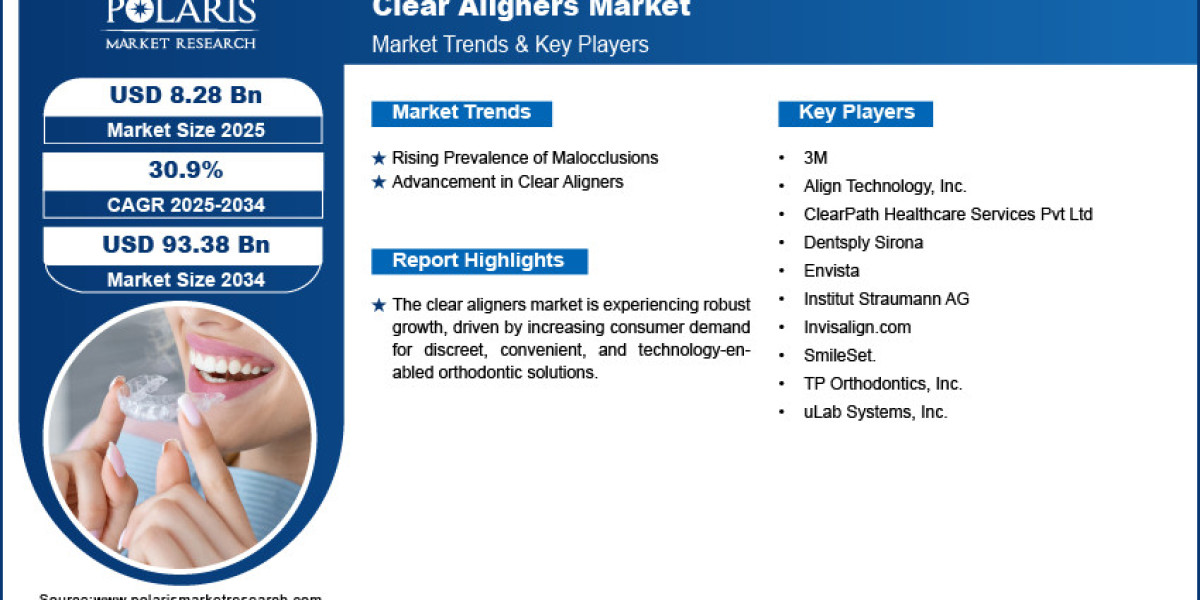Clear aligners are transparent orthodontic devices designed to straighten teeth without the need for metal brackets or wires. They have revolutionized the field of orthodontic treatment by offering a more comfortable, aesthetically pleasing alternative to traditional braces. The market for clear aligners has expanded rapidly over the last decade, driven by increased acceptance among dental professionals, growing consumer preference for minimally invasive procedures, and improved access to orthodontic services.
The global clear aligners market size was valued at USD 6.34 billion in 2024. It is expected to grow from USD 8.28 billion in 2025 to USD 93.38 billion by 2034, at a CAGR of 30.9% during 2025–2034.This growth is largely attributed to the rising number of orthodontic cases, advancements in digital dental imaging, and a surge in demand from emerging economies. Additionally, the integration of AI-driven treatment planning and 3D printing technologies is improving the efficiency and customization of aligner production.
Clear aligners are being widely adopted across age groups, particularly among young adults and working professionals who seek discreet teeth alignment solutions that align with their lifestyle needs. The flexibility of removable trays, fewer dental visits, and shortened treatment durations are all major factors bolstering adoption.
Market Trends by Country
United States
The United States remains the largest consumer of clear aligners, driven by early adoption of advanced dental technologies and a highly aesthetic-conscious population. The market is benefiting from a strong base of dental professionals trained in orthodontic treatment with clear aligners, as well as growing direct-to-consumer awareness through digital marketing campaigns. Millennials and Gen Z are fueling demand by seeking fast and non-intrusive solutions to enhance dental aesthetics.
Furthermore, increased access to dental insurance covering orthodontic treatments and the growing availability of at-home impression kits have further widened the consumer base. With over 4 million people currently undergoing orthodontic care in the U.S., a considerable percentage now prefer invisible braces over traditional ones.
Canada
Canada is experiencing steady growth in the clear aligners market due to rising awareness of oral health and an increasing number of orthodontic consultations. Patients are showing a strong preference for cosmetic enhancements, particularly among urban populations in cities like Toronto, Vancouver, and Montreal.
The expansion of private dental clinics offering clear aligner services and government initiatives promoting dental wellness have contributed to market development. Demand is also growing in regional areas as tele-orthodontics and virtual consultations become more prevalent.
United Kingdom
The United Kingdom has emerged as one of the prominent European markets for clear aligners. With a rising trend toward cosmetic dentistry and personal grooming, demand is especially high among professionals aged 25–45. NHS orthodontic services, though extensive, often involve long waiting periods and limited cosmetic treatment options, pushing consumers toward private dental clinics that offer clear aligner alternatives.
The UK's booming health and wellness culture has also integrated dental aesthetics as a vital component, leading to increased uptake of minimally visible orthodontic solutions like clear aligners.
Germany
Germany's well-established dental infrastructure, combined with a rising elderly population keen on improving their dental aesthetics, is boosting the adoption of clear aligners. German patients often favor technology-backed medical treatments, and the country’s high per capita healthcare spending supports strong market penetration.
Read More @ https://www.polarismarketresearch.com/industry-analysis/clear-aligner-market
Advancements in intraoral scanning and CAD/CAM technologies are being readily adopted by German orthodontists, enabling more precise and customized clear aligner solutions. Additionally, a growing segment of younger consumers in urban areas is turning to invisible braces for preventive orthodontic care.
France
In France, increasing aesthetic awareness and the adoption of wellness-oriented lifestyles are key drivers of the clear aligners market. Consumers are increasingly exploring orthodontic treatments that do not interfere with social and professional interactions. The French market has seen rapid acceptance of clear aligners in recent years, particularly among women aged 20–40.
Despite higher treatment costs, the convenience, comfort, and nearly invisible appearance of clear aligners are making them a popular choice in cities such as Paris, Lyon, and Marseille. A trend toward “smile makeovers” in cosmetic dentistry is also driving market traction.
Australia
Australia is witnessing growing demand for clear aligners, especially among teenagers and young professionals in metropolitan areas. The market benefits from a strong emphasis on oral health within the country’s healthcare system and widespread access to dental care services.
Orthodontic treatment is increasingly viewed as a confidence-boosting investment, and Australians are turning to clear aligners for faster and less conspicuous treatment options. Lifestyle influencers and digital campaigns have played a role in making clear aligners a mainstream solution among the youth.
India
India’s clear aligners market is expanding rapidly, fueled by rising disposable incomes, increased awareness about dental aesthetics, and the growing popularity of preventive dental care. Urban centers such as Mumbai, Delhi, and Bangalore are leading in terms of adoption, with a significant push from private dental networks and clinics.
The younger population is highly image-conscious and tech-savvy, driving interest in innovative and invisible orthodontic solutions. Local manufacturing of aligners and cost-effective treatment plans are also making them more accessible to middle-income segments. The government’s push for better healthcare access in tier-2 and tier-3 cities is expected to further boost demand.
China
China represents one of the fastest-growing markets for clear aligners in the Asia-Pacific region. With a growing middle-class population and rising healthcare spending, Chinese consumers are increasingly seeking cosmetic dental treatments that align with modern beauty standards.
Tech integration in dental clinics—especially the use of AI in diagnosis and treatment simulation—has accelerated consumer confidence in clear aligners. Social media platforms have also played a significant role in popularizing invisible braces among China’s digitally native youth.
Japan
Japan’s aging population, combined with a culture that values discretion and cleanliness, creates a unique demand for clear aligners. Older adults are increasingly seeking orthodontic care for functional and aesthetic reasons, while younger consumers prefer removable and transparent solutions that don’t interfere with social etiquette.
Dental professionals in Japan are incorporating 3D scanning and personalized treatment plans to cater to these expectations, and as a result, clear aligners are gaining significant market share over traditional options.
Brazil
In Brazil, dental aesthetics are closely linked to self-confidence and social appeal, making orthodontic care a popular healthcare segment. The market for clear aligners is growing swiftly, particularly in São Paulo and Rio de Janeiro, where cosmetic dentistry is widely sought.
Lower production costs and a surge in orthodontic training have supported the growth of affordable and accessible clear aligner options. Young adults and working professionals, in particular, are driving demand due to the aligners' discreet appearance and ease of use.
Conclusion
The clear aligners market is undergoing a dynamic transformation worldwide, propelled by a shift in consumer preferences toward discreet, efficient, and technologically advanced orthodontic treatment solutions. As demand surges across key global markets—from North America to Asia-Pacific and Latin America—clear aligners are expected to become a mainstream component of dental aesthetics and healthcare.
More Trending Latest Reports By Polaris Market Research:
Advanced Wound Care Management Market
Age-Related Macular Degeneration (AMD) Market
Internet Of Things (Iot) In Healthcare Market








